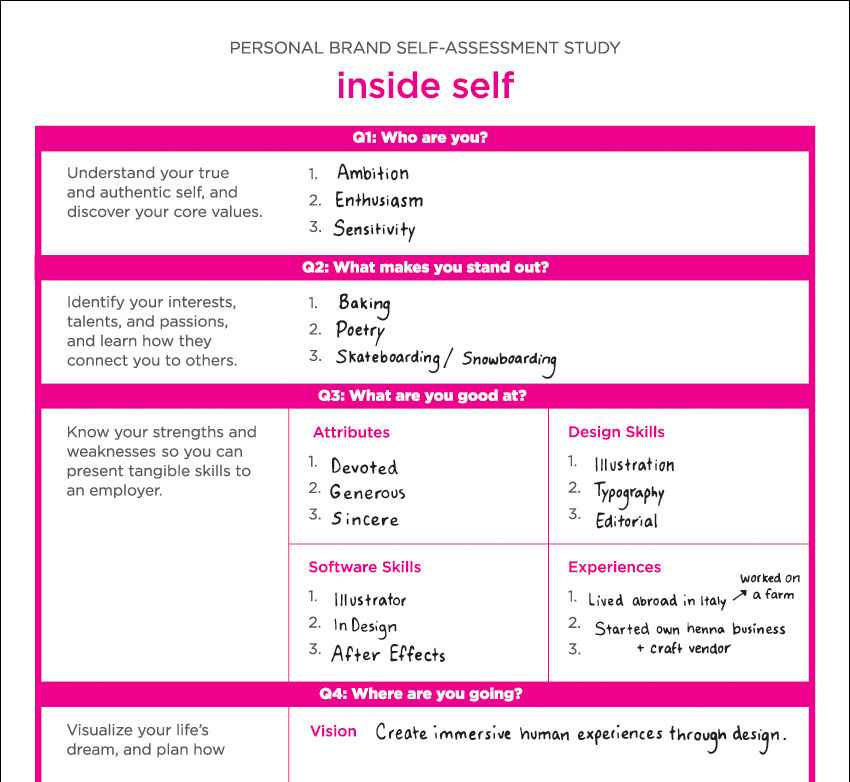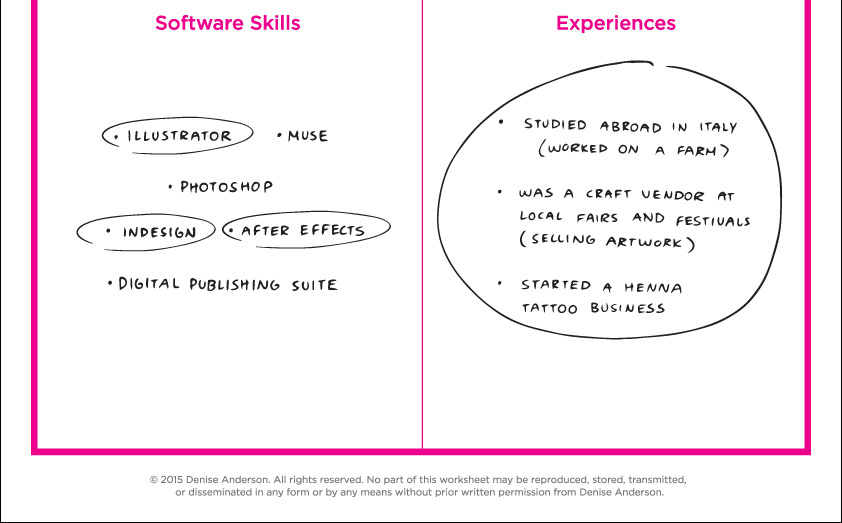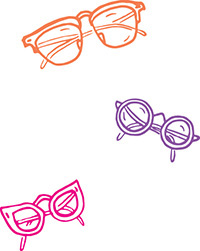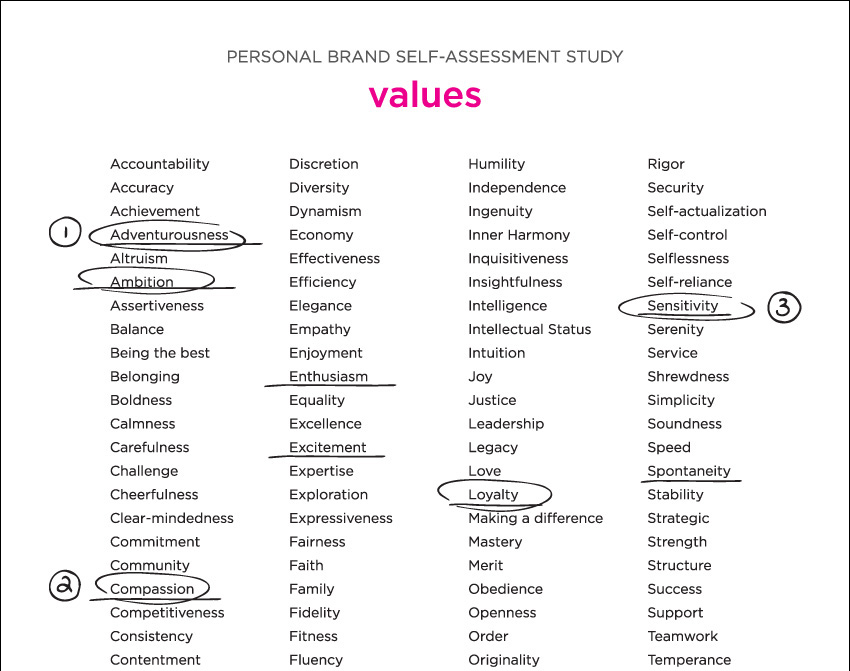1. Get Personal with Your Brand
Identifying your brand, its purpose, and the attributes that make it your own.
Your personal brand is the past, present, and future idea of you. Intangible and ever-present, it encompasses the sum of your parts: your values, interests, skills, personality, behavior, and style. It is what people think, feel, and say about you when you are not in the room and what you believe about yourself.
Some people have a fairly good understanding of who they are, but communicating one’s self to others can be challenging. Taking an active role in defining your personal brand empowers you to take control of what you project to others: who you are, what you want, and why an employer should hire you.
Before you can reveal and unleash your personal brand as a brand identity, you must first tap into your inside self—your true and authentic self—to gain insights on who you are and what you want to be. You must also gain a clear understanding of your outside self—how the world perceives you—by researching and asking others. Recognizing the connection between how you see yourself and how others see you gives you the ability to develop a compelling and credible personal brand that truly represents who you are.
As you create or update your design portfolio and prepare for the next phase of your life, performing this kind of evaluation is essential for two reasons:
• First, the process will propel your personal and professional growth, and the resulting insights will enrich the story you’re telling.
• Second, your insights will translate into visual cues for the design of your brand identity.
Understanding yourself, inside and outside, may even lead you to modify your personal strategy or redefine it to embrace the person you are and the one you’re stretching to become.

Before you can define your personal brand, you need to do some research. If you’re building your portfolio, you’ve already been through the process of researching and creating a unique brand that reflects a client’s character. Doing a self-assessment study is the same thing, except you will be focusing on yourself, to explore, identify, and conceptualize the ideas that represent your brand.
This kind of work can sometimes be uncomfortable, but the outcome is worth the effort. When my students begin this task, I tell them, “Take yourself out on a date. Buy yourself a cup of coffee or a cocktail (if you’re old enough), and get to know you better.” It may sound silly, especially when you’re beginning the very serious journey of launching or relaunching a professional design career, but it is necessary. As you work your way through the exercises in this chapter, schedule time to be alone and reflect. Shut off your phone and disconnect from social media for a few hours. Keep your responses brief, and don’t overthink the questions.

You can learn a lot about yourself by looking at what is important to you. When the way you live matches the values you hold dear, life feels fluid and effortless. But when your activities are not aligned with your values, you feel out of sorts and perhaps even truly unhappy. Being mindful of your values is tremendously important. Once you understand what you care most about, you can identify what fuels your purpose, and you will have discovered your true and authentic self.
In the course of my own career, I have been an entrepreneur (owner of a Baskin-Robbins ice cream store and the founder and leader of DesignDMA, a graphic design company), managed the design group of a financial services company (Pershing, LLC), and taught as an adjunct professor in a university (Robert Busch School of Design at Kean University). When I conducted my own self-assessment study in graduate school, I was able to identify a thread that runs throughout my career—mentoring young people. If I hadn’t bothered to do the study, I wouldn’t have recognized or been able to embrace such an important fact (or core understanding) about myself. I might have missed out on teaching full-time or sharing what I’ve learned with others through writing and speaking opportunities. And, I would never have been truly satisfied in my career. Because I took the time to go through this process, I am able to say without reservation that I never feel like I am working because I truly love what I do.
This exercise will help you identify your core values—the principles that guide your attitudes, actions, and who you are. Your answers will serve as benchmarks for evaluating your life choices. Figuring out what inspires you will lead you to a job you truly love and are meant to do.


Inside Self: What makes you stand out?
Identify your interests, talents, and passions, and how they connect you to others.
Your talents, interests, and passions are the unique differentiators that help define you and distinguish you from others. It’s important to identify what they are and how they relate to your goals, because any one of them could turn out to be the key factor in getting you noticed by a potential employer or hired for the job you’ve always wanted.
Liz Blazer, motion designer and author of the book Animated Storytelling: Simple Steps to Creating Animation and Motion Graphics, uses a whimsical term for this practical procedure: “Finding your pixie dust.” What this means is bringing to light your interests (things you find stimulating), talents (aptitudes you are born with), and passions (your developed interests and talents) so you can market and share them in a useful way. My former student, Max Friedman, discovered his pixie dust while authoring and designing a series of books. In grade school, Max had always enjoyed doodling, but working on the book series resurrected his interest, which quickly evolved into a genuine passion for illustration.
Identifying your own unique differentiators (i.e., pixie dust) is essential. Without it, your brand will be lackluster and non-differentiating, ordinary instead of magical. Employers are looking for talented and skilled professionals, but designers with rich experiences, unique interests, and notable passions will captivate their attention.
A caution: Some interests, talents, and passions may be too personal to reveal in a professional environment. They don’t have to be specifically related to a design job, but their attributes should translate to the skills you need for the work you want to do. Anything you present should be true and appropriate for both the market you intend to work in and the type of company you want to work for. You should feel good about the personal things you share and understand why you are sharing them.
Inside Self: What are you good at?
Understand what you are good at (and not so good at), and how to talk about it.
No one is good at everything, but everyone is good at something. Some designers excel at conceptualizing, while others are better at production. Your strengths are not just the things that you have an aptitude for; they also drive you to the tasks that you enjoy most. Those strengths continue to improve because you spend more time using them.
You may have character or personality traits—personal attributes—that work to your benefit. For example, if you are a good listener, communicative, and organized, you may excel as a team leader. Your positive attributes can strengthen your personal and professional relationships. (The ability to recognize your character and personality traits is in itself a positive attribute.)
You’ll find your weaknesses, on the other hand, in the things that don’t interest you or for which you have no aptitude. Maybe you lack a skill set or talent to excel in that area, or maybe you just don’t enjoy it. Like it or not, there’s a good chance you’ll be asked about your weaknesses in an interview. If you know what they are, you can find a way to use them to your advantage. For example, you may not like working early in the morning, which is reflected in the quality of your work. Understanding that limitation, you can position yourself as a good candidate for a company with flexible hours that extend past the traditional 5 p.m. quitting time.


After reflecting on your inner self, you now have a foundation for envisioning what you want your life to be. Your vision statement is very personal because it consolidates everything you’ve learned about yourself so far—your values, “pixie dust,” passions, strengths, weaknesses, skills, and experiences—into a precise destination, the dream that awaits no one but you. Your mission statement is the road map you will use to get there.
Based on personal values and beliefs, your vision statement articulates your ultimate purpose or calling in life. It involves detailed visualizing and thinking about what you see happening in your future.
The mission statement is the step-by-step plan you will use to achieve your vision. Comprised of three to four detailed “how to” objectives that will move you toward fulfilling your vision, your mission statement will serve as a set of guidelines to remind you of the goals you have set.
One of my first steps in writing this chapter was to conduct my own personal brand self-assessment study. I have to confess that I panicked for a moment as I tried to figure out how to squeeze each exercise in between writing, teaching a full course load, and caring for my family. But I’m glad I did. I am sure you’re thinking something along the same lines as you contemplate creating or refreshing your brand, updating your book of work, and finding a job, especially if you already work or have family obligations. I hope you will trust me—I’ve seen this formula and these concepts work for my students time and again. Once you get a design job, this leg of your journey will be complete. Take it slowly and enjoy the ride.
On the next page, you’ll find my vision and mission statements, along with those of some of my students.

It is time to consider your public persona and strengthen your awareness of how you are perceived by others.
Your outside self is the expression of what others perceive you to be—your attributes, behavior, and personal style. It’s important to understand how your friends, family, professors, mentors, colleagues, and acquaintances see you, because those perceptions all add up to a personal brand equity that has already been established.
In your search, you may learn a few things that you don’t like. Some observations may be difficult to hear (but don’t be surprised if much of what they tell you is positive). If you want to know and embrace the true and authentic you, you’ll have to consider the bad stuff as well as the good.
As part of my self-assessment study, I had an online survey sent to 20 friends, family, colleagues, and students. I was excited to see that several respondents perceive me as creative, passionate, and driven. For my weaknesses, someone said I am intimidating. (The survey was anonymous, but I’m fairly certain this comment came from my good friend Suzanne, who believes this “weakness” is not such a bad trait. More on that later.) Others said I am impatient. (Ouch, and yes I am.) I didn’t like everything I read, but that feedback helps me better understand how my personal brand is perceived by others. I can use this information to improve my image.
Here is a breakdown of how others will assess you:
Attributes. These are the qualities or characteristics ascribed to you. They are aspects of your personality that cannot be altered much and would tend to be reflected in the words others use to describe you. Do they see you as assertive or shy? Flexible or difficult? Impulsive or deliberate? Witty or sarcastic? Responsible or flighty? As you learn more about your personality, you’ll become increasingly self-aware, and your path for development will become clearer and more direct. Everyone is different: once you understand what your differences are, you can embrace your individuality and build a strategy for becoming the person you want to be.
Behavior. The way you conduct yourself in public, in the classroom, at a job, or at home can influence how others perceive you. Will a professor provide you with an enthusiastic reference when you’re chronically late or your work is sloppy and unfinished? Will your dad lend you the car to get to an interview if you are unreliable and never bring it back when you say you’re going to? Like it or not, your behavior communicates the strengths and weaknesses of your character to the people around you. What message are you sending?
Personal style. Your body language, the way you dress, and the people you associate with are just a few of the many personal style choices that speak volumes about your brand. A strong but warm handshake communicates you are confident and trustworthy. A stylish and well-tailored suit conveys that you can dress appropriately in a professional environment. If you want to communicate that you have an eclectic (or conservative or trendy or whatever) fashion sense, that’s okay, but you should consider what your choices communicate to a potential employer and how it could impact their decision-making.

Create a survey. Create your own customizable survey that asks questions specifically about you. Use a free online survey tool such as Survey Monkey (surveymonkey.com), or create your own form using Adobe Acrobat or Google Forms.
• When you hear my name, what qualities do you think of?
• What am I really good at?
• What are my most likable and most annoying personality traits?
• Have I impacted or influenced your life? Another person’s life?
• After all the time we’ve known each other, why do you still want to hang out with me?
• What color best describes me and why?
• What animal comes to mind that would best represent me?
Interview people. There is nothing more enlightening than sitting in front of someone you know and actually seeing that person respond to one of your questions. Words can lie, but non-verbal reactions will be much more honest. Here’s a tip: select people from your most trusted circle. They will take this exercise seriously and provide the cues you need to form a view.
Assess your social media presence. In social media, you publicly promote your personal brand. Social networking means putting your personal life (and sometimes, your professional activities) on display for anyone to see for an indefinite and possibly extended period of time. When you chat about what you like to do, the movies you see, or your favorite restaurant, you are sharing the private details of your life with everyone. Consider the tone of your posts—are you supportive and encouraging? Argumentative or mean-spirited? Do you post constantly? Are you obsessed with cute kitten videos and trendy memes? (When I discuss this topic with students, I jokingly suggest taking down the pictures of themselves doing keg stands. After seeing the terror on more than a few faces, I no longer consider it a joke.)






